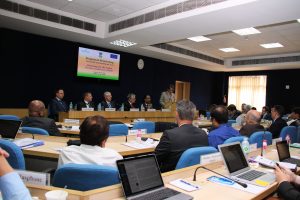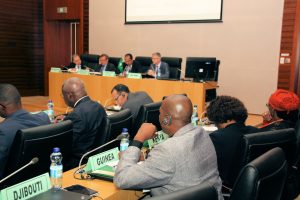Beneath the Crust …
… the lava continues to flow unseen by the casual observer standing above
On 3 November I was invited to speak at an international conference in Brussels organised by the European Union (EU) Non-Proliferation Consortium. The session was called: The Biological and Toxin Weapons Convention (BTWC) – Maintaining Relevance. I found the title intriguing. Is the BTWC losing its relevance one way or another? Is this treaty in jeopardy?

A widely shared opinion has it that the BTWC is a weak treaty. Yet always unspoken remain the criteria by which people assess the treaty’s weakness. They often point to the Chemical Weapons Convention (CWC) as a strong agreement because it has an international organisation, a verification regime and mechanisms to enforce compliance. Notwithstanding, in its almost twenty years of existence, war and terrorism in the Middle East accounts for about 2,000 fatalities as a direct consequence of chemical warfare and terrorism with chemical weapons. The BTWC, in contrast, lacks an international organisation or verification mechanism, yet in its 41 years since entry into force, deliberate use of disease or toxins has killed fewer than 100 persons. What does that say about the strength of a treaty?
Moreover, the BTWC is actually a very active treaty. Since 1991—the 3rd Review Conference—states parties have come together in Geneva at least twice a year, sometimes even more, particularly while negotiating a legally-binding protocol between 1997 and 2001. Of course there is a lot of frustration with the formal process and its lack of tangible progress in upgrading the treaty, its institutional support and procedures. In contrast a lot moves on the local and regional levels.
The BTWC World Tour 2016
To that conclusion I arrived after having organised four regional and sub-regional seminars between March and the end of September 2016 on behalf of the BTWC Implementation Support Unit (ISU). Those meetings took place in the framework of the EU Council Decision 2016/51 of 18 January 2016 supporting the BTWC and are part of a much broader package of activities envisaged between 2016 and 2019.
This Council Decision is the fourth in a series over the past decade. The first one covered the period 2006–08; the second one 2009–11 and the third one 2012–15. In total the EU has now invested some 6.3 million Euros in the strengthening of the BTWC, including 2.3 million for the current programme.

As Director of the international non-governmental organisation BioWeapons Prevention Project, I had the privilege of being entrusted with the implementation of the first Joint Action (as actionable Council Decisions were then known), part of which was designed to prepare the 6th Review Conference at the end of 2006. At this point the ISU, which was to carry out the next EU support plans, had not yet been established .The Joint action consisted mainly of BTWC universalisation and national implementation assistance activities. The former comprised five regional seminars: Southern and East Africa (Nairobi, Kenya on 21–22 June 2006; Asia and the Pacific Islands (Bangkok, Thailand on 8–9 November 2006; Latin America and the Caribbean (San José, Costa Rica on 18–19 January 2007); West and Central Africa (Dakar, Senegal on 17–18 April 2007); and the Middle East (Rome, Italy on 16–17 April 2008).

The current Council Decision envisages four regional workshops in preparation of the 8th Review Conference to be held between 7 and 25 November 2016. Because of the short intervals between the events, the series became jokingly known as the BTWC World Tour 2016 and the organisers flew on BioForce One, a wink to Iron Maiden’s Ed Force One carrying the rock band’s members and crew to concert venues across the planet.
The four events targeted Eastern Europe and Central Asia (Astana, Kazakhstan on 15–16 June); South and Central America (Brasilia, Brazil on 22–23 August); South and South-East Asia (New Delhi, India on 29–30 August) and Africa (African Union Commission, Addis Ababa, Ethiopia on 13–14 September).
My remarks at the EU Non-Proliferation Consortium conference drew on insights from the four regional workshops this year and earlier experiences with the first EU Joint Action.
Evolution of a treaty regime and trends in state practice
Anyone participating in meetings on science and technology review, developments in industrial capacities, new production processes and technologies hears a lot of anxiety and a lot of talk of threats to the convention or possible weakening of the norm. However, such developments never take place in a vacuum, even if substantive progress in the Geneva negotiations remains elusive. Looking at several states that participated in this year’s regional meetings, I can only observe how much things have evolved.
India is a prime example. I recall a seminar the BWPP organised at the United Nations in Geneva in 2004 or 2005. We had an Indian scientist present and she described how her country was on the verge of becoming a net exporter of biotechnology, whereas before it had been a net importer. She predicted that India would soon assume new types of responsibilities to govern the new science and technologies. Last August I was in New Delhi for the third regional seminar. At one point a discussion between Iran and India over the latter country’s export control legislation started up. It was interesting to note the evolution in India’s position on export controls. It had adopted principles that only 5–10 years ago were extremely controversial internationally. China has undergone a similar evolution with respect to national technology transfer policies and its adoption of a certain rationale behind them. These developments testify to a convergence of ideas, a convergence of approaches among states in different parts of the world. In turn they lead to circumstances that enable and promote cross-continental, cross-regional cooperation in a number of issue areas. In preparation of the 8th Review Conference the ISU website contains several working papers written jointly by European and Asian states, European and South American states, or the United States with partners in different regions. They illustrate emerging possibilities for the future of the BTWC. They do not yet translate into formal agreements or new understandings, but they testify to evolving practice that keeps the convention alive despite frequent setbacks in multilateral negotiations.
A second aspect of the BTWC’s vitality that emerged from the four regional seminars concern the different facets of international assistance and cooperation for peaceful purposes under Article X. Exchanges between especially some members of the Non-Aligned Movement (NAM) and the Western Group in Geneva are usually politically highly charged. Similar confrontations one can also observe in meetings of the decision-making bodies of the Organisation for the Prohibition of Chemical Weapons (OPCW) with respect to the comparable Article XI of the CWC. Yet, over the past decade parties to the BTWC have managed to advance matching expectations with obligations on both the global and regional levels.

First, the intersessional process has tended to focus on actionable programme items. In Geneva states parties often discuss Article X in broad, abstract principles. As already mentioned, they also tend to pit the NAM against the Western Group. Several vocal NAM members view national export controls as a violation of the convention and consequently place the prohibition on transferring biological weapons (BW) and relevant technologies to any recipient whatsoever in Article III in direct opposition to Article X. The intersessional process, in contrast, encourages states parties to look at the quality of their national implementation of obligations and responsibilities. This has led them to articulate concrete needs and requests, including under Article X, which in turn made it easier for potential donor countries to formulate offers for assistance and cooperation. Matching happens bilaterally or interregionally with the BTWC ISU often acting as a facilitator. To most developing countries the feckless ritual standoff with its sweeping statements in Geneva runs counter to specific national needs.
Second, certain developing countries have taken a regional lead in technology, science development, and so on. Some even work at the leading edge globally. Over the past few years they have initiated processes whereby they transfer relevant knowledge, expertise and practices to neighbouring states. In other words, regional patterns of cooperation, training and education explicitly undertaken under Article X have emerged. Argentina plays such a role in South America. Similar initiatives have arisen in the context of ASEAN, particularly in the area of biorisk management. Such concrete regional assistance also includes help with national implementation legislation, the submission of the Confidence Building Measures (CBMs), and so forth.
Re-emerging regionalism to BTWC negotiations?

Related to the latter development, but not specifically linked to Article X, I noticed egress of a certain degree of regional consciousness, if not identity across the seminars for Eastern Europe and Central Asia, South and South-East Asia and Latin America. Several participants wished to develop and articulate a clearer regional dimension in the Geneva forums, be it in the 8th Review Conference or at intersessional meetings. Politically some reluctance persisted regarding certain issue areas, but the desire definitely came to the fore. At the 6th Review Conference (2006) such a trend had been quite prominent. For instance, the Latin American countries then made several collective proposals. EU members submitted almost all working papers as joint documents, thereby emerging as a distinct entity in the Western Group. The JACKSNNZ comprised another Western Group collective but minus the EU and the USA: Japan, Australia, Canada, South Korea, Switzerland, Norway and New Zealand. Most interestingly, working papers by the traditional antagonists in Geneva tended to become outlying propositions, whereas those presented by either the JACKSNNZ or Latin America came to represent a centre upon which consensus could be crafted. (The EU was less successful in this respect, because the working papers had gone through a lengthy and delicate internal negotiation process. As a consequence, it became all but impossible to demonstrate timely flexibility as negotiations at the Review Conference gathered pace or to abandon one position in favour of potential success in another issue area.) Informal regionalism contributed to the successful outcome of the 2006 Review Conference, but petered out during the subsequent series of intersessional meetings. Based on exchanges during the regional seminars and in view of the tendency towards regional cooperation in implementing the BTWC, (informal) regionalism may resurface over the next years.
Avoiding communication breakdown
The meetings organised under the 2016 EU Council Decision targeted primarily officials responsible for BTWC matters in capitals. Consequently, a third element that came to the fore is the disconnect between the desk officers in capitals and the Geneva delegations. The people on both sides of the communication use different frameworks. When diplomats in Geneva seek instructions from capital, the latter frequently does not understand the question. Absence of concrete guidance makes the BTWC deliberations boring. Without any cue of how to contribute to solutions or advocate national interests, their sense of futility only increases. Many seminar participants (who mostly came from capital) found the discussions in Geneva abstract and the information they are receiving appeared to have limited bearing on their daily work. This need how to express oneself in Geneva or to understand the issues under discussion in the BTWC forums in capital warrants further investigation and elaboration so as to devise specific types of assistance activities.
A continent in search of greater involvement
A fourth element pertains specifically to Africa. With the exception of communication difficulties between delegations and capital, the trends described above were noticeably absent from the exchanges at the regional meeting in Addis Ababa.
Several countries on the African continent are leaders in terms of biology, the life sciences and biotechnology. They include Kenya, Morocco and South Africa. However, contrary to Latin America or South-East Asia, no radiation from these three countries to neighbouring states or within the region can be observed. During the final discussion session of the workshop for Africa one of the participants asked me to compare the regions. When I mentioned the lack of spontaneous mutual cooperation people were surprised, but upon reflection acknowledged this was the case. Therefore, stimulating the more advanced countries to engage regionally or subregionally would benefit Africa’s commitment to the BTWC.

Africa is also the continent with the largest number of non-states parties. A lot of work in support of universalisation remains. From different interventions it was apparent that the African Union is taking up the BTWC as a priority issue. For other states parties it therefore makes sense to interact more with this regional organisation because it wants to set up programmes to stimulate universality, including what I call ‘qualitative universality’—the quality of national implementation of obligations.
Another observation of mine may not be entirely politically correct: a big difference in attitude towards the treaty exists between the Anglophone and Francophone countries. Generally, representatives from Anglophone countries appear well aware of issues; those from Francophone countries less so. After the workshop I spoke with officials from both linguistic communities. Both sides acknowledged the discrepancy. (African participants in the EU Non-Proliferation Consortium conference in Brussels did so too.) However, it was not immediately clear why it existed. At the Brussels conference I reflected on how easy it is to speak in English, to organise events in English. However, equivalent activities for Francophone communities are rare, which might explain lower levels of general awareness and knowledge. Relevant literature in French to bridge such gaps is also less prevalent. To design assistance programmes or set up outreach activities for Francophone countries may require some preliminary investigation into the causes of that particular discrepancy.
Unlike in the other regional meetings unawareness of the BTWC or the norm against BW existed even among a few persons sent by their government to attend the Addis Ababa meeting. In one particular egregious instance the question even came up why biological weapons should not be used. Admittedly, a representative from a non-state party suffering badly from internal war asked it. Nevertheless, such absence of an overall sense of normative frameworks that govern international relations or international security demonstrated how easily a globally accepted interdiction might be breached once societies break down.
These observations do not imply that Africa has not progressed over the past decade. Quite on the contrary. To give but one example: when I was organising the regional seminars in Nairobi and Dakar under the first EU Joint Action, the respective target countries were contacted through the Foreign Ministry, typically via the Political Director. However, the actual desk officer responsible for the BTWC often functioned as if in a stovepipe. He or she had no colleagues on the same level. All communication was vertical via the immediate superior and director-general. That person had no lateral contacts, even with equivalent functions in other ministries. Today, people are aware of the need to involve different departments or agencies and have established lateral contacts with them. At the workshop in Addis Ababa some African countries—not necessarily the most advanced or richest ones—were represented by 2–3 officials from different ministries despite the limitation of the EU sponsorship to a single country representative. Moreover, people are aware of their counterparts in other countries, a situation that can only further improve as more states parties set up national focal points for the BTWC.
By way of conclusion
My fifth and final point concerned the ways in which assistance and cooperation can be best organised in view of the apparent region-specific dynamics in support of the norm embedded in the BTWC. How can the international community stimulate these trends further without becoming too intrusive into what I would call ‘natural’ regional processes?

Regional or local assistance programmes might wish to engender interest in the convention by not departing from the BTWC. Indeed, regional or local perspectives on the relevancy of an international disarmament convention may differ considerably from those in North America and Europe, both of which have a very strong law-based attitude to international relations. Not all cultures entertain a similar formalistic, legal point of departure. Some issues such as terrorism may not be that salient to people in other parts of the world; local concerns may be focussed more on things such as biological diversity or the environmental or economic impact of genetically modified organisms, and so forth. Perhaps strategies need to be developed so that these local concerns become the starting point for shifting or expanding the knowledge about the BTWC, and translating the many topics under discussion in Geneva with reference to issues as local people experience them. This reflection arguably pertains more to building a national consensus about the value of the norm that permeates all aspects of scientific and technological activities than to a nation’s legal obligations under the BTWC.
Postscript
Since my presentation at the conference by the EU Non-Proliferation Consortium on 3 November, the 8th BTWC Review Conference ended in great disappointment. The outcome underscores the need to continue the types of activites described above. Two further blog postings on the BTWC are being prepared, an account of a second workshop on Africa’s implementation of weapon control treaties I attended in Addis Ababa on 9 December and an analysis of the outcome of the Review Conference.
This contribution also features in the Winter 2016 issue of CBW Magazine: Journal on Chemical and Biological Weapons, published by the Institute for Defence Studies and Analyses, New Delhi, India.
(Picture of Ed Force One by Michael Hallam, posted at UK Airshow Review Message Board; all other photos by Jean Pascal Zanders.)

1 Comment
Non-proliferation assistance: A proliferation of national focal points? | The Trench
[…] of such a national contact point. As I have been able to experience firsthand when preparing the four regional workshops in preparation of the 8th Review Conference on behalf of the ISU, the absence of such a contact point seriously complicated speedy communications as all questions […]